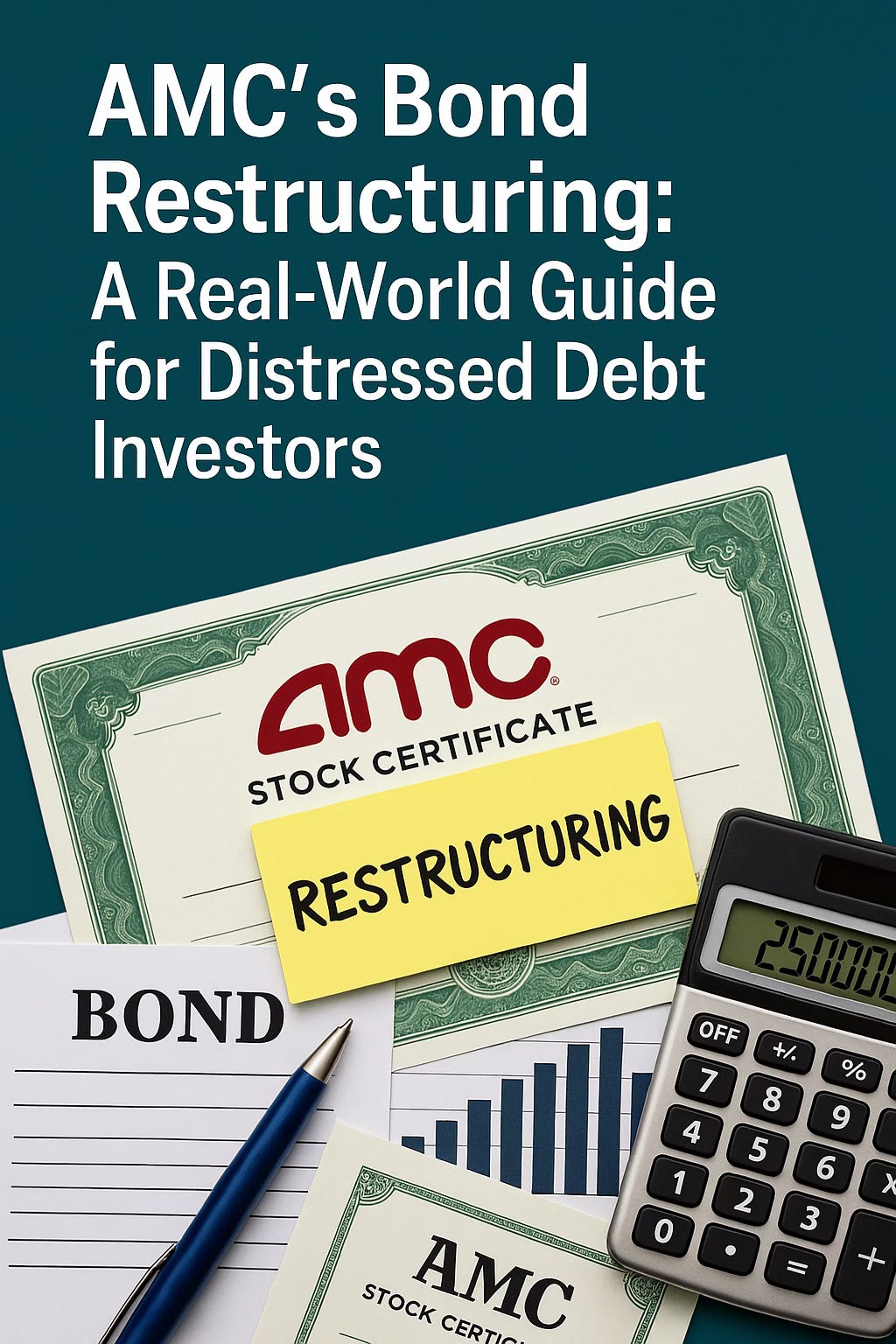Rafael Benavente AMC’s Bond Restructuring (UPDATE)
AMC’s Bond structuring: A Real-World Guide for Distressed Debt Investors (Updated July 2025)
When companies teeter on the brink of collapse, chaos breeds opportunity—and for savvy distressed debt investors, few situations better illustrate this than AMC Entertainment’s latest bond restructuring in July 2025.
In this updated guide, we break down AMC’s evolving financial situation, its high-stakes restructuring effort, and what it all means for investors navigating the volatile world of distressed debt. Whether you’re a bond trader, equity speculator, or long-term value seeker, AMC’s situation is a case study in both risk and reward.
🔍 AMC’s July 2025 Restructuring: Key Highlights
In a bold attempt to avoid bankruptcy and restore financial stability, AMC launched a multi-pronged restructuring plan:
💰 $223.3 Million in New Financing
Designed to refinance 2026 maturities, this cash injection temporarily alleviates default risk. The funds buy AMC time—but not much margin for error.
🔄 $143 Million Debt-for-Equity Swap
Holders of 6–8% exchangeable notes due 2030 agreed to convert debt into 79.8 million new AMC shares, creating an ~18.5% dilution of common equity on day one. Up to $337 million more could be converted, increasing potential dilution to over 21.5%.
🔁 $590 Million Secured Bond Exchange
AMC replaced existing 7.5% 2029 secured notes with newly structured secured bonds. This resolved litigation from disgruntled bondholders and restored clear collateral rights—crucial in bankruptcy scenarios.
🗳️ Over 80% Lender Consent
Crossing this key threshold allowed AMC to execute its restructuring terms without protracted legal battles.
📊 AMC Financial Snapshot (as of Q1 2025)
MetricValueRevenue$862.5 million (−9% YoY)Net Loss–$202.1 millionCash Burn–$370 million from operationsFree Cash Flow–$417 millionCash on Hand$378.7 millionTotal Debt (pre-restructuring)~$4.08 billion
This marks the worst Q1 box-office performance since 1996, reinforcing investor concerns over whether AMC can survive without a cinematic rebound.
🎯 What This Means for Investors
📉 Discounted Bond Buyers
Investors who scooped up AMC bonds at 30–70 cents on the dollar now have a high-yield play. If AMC stabilizes, they could enjoy strong capital appreciation and coupons. But the risk of default remains elevated.
🔁 Exchangeable Noteholders
Debt-for-equity swaps convert debt into upside potential, but at the cost of shareholder dilution. If AMC rebounds, these hybrid holders could see significant gains—but if not, they hold low-value stock instead of senior debt.
💥 Common Shareholders
Suffer immediate dilution (~18.5% and counting). However, they could benefit from lower interest costs and reduced bankruptcy risk—if revenues recover.
📉 Three Possible Scenarios for AMC Investors
🚨 Scenario 1: Bankruptcy Within 12–18 Months
If revenues remain depressed and cash burn continues, AMC may exhaust liquidity by mid-2026. Here’s what could follow:
Secured bondholders: 40–70% recovery in Chapter 11 court.
Unsecured/junior bondholders: 10–30% recovery—or total wipeout.
Equity holders: Near-total loss likely.
📊 Scenario 2: Gradual Stabilization
With a 15–25% box-office recovery, AMC might slow its burn rate and make interest payments, avoiding bankruptcy:
Bonds rally to 80–90 cents on the dollar.
Converted equity gains value, helping bondholders-turned-shareholders.
Common stock stabilizes as debt overhang eases.
🎬 Scenario 3: Surprise Box-Office Boom
A wave of blockbuster hits or a surprise franchise revival could restore profitability:
Bonds return to par, offering 30–100% gains.
Converted shares surge, offering significant upside.
AMC stock rallies, aided by meme-stock momentum and renewed optimism.
⚠️ Key Risks to Monitor
📉 Dilution Risk
New share issuance (up to hundreds of millions of shares) could crush existing equity value unless AMC generates real earnings growth.
📊 Priority Risk
Junior bondholders and shareholders are subordinate to secured creditors. If AMC falters, they’re at the back of the recovery line.
🧩 Execution Risk
AMC’s survival hinges on execution: reducing costs, improving attendance, and releasing profitable titles.
🎢 Meme Volatility
Retail investors on Reddit and X (formerly Twitter) continue to cause massive volatility. AMC remains vulnerable to swings unrelated to fundamentals.
🧠 Lessons for Distressed Debt Investors
AMC’s case offers real-world insight into the complexity of distressed investing:
1. Know the Capital Stack
Not all debt is created equal. Secured bonds have collateral; unsecured debt does not. In distress, seniority determines recovery.
2. Model Recovery Scenarios
Assess what AMC’s assets and cash flows could realistically support in a liquidation. The 40–70% recovery estimates for secured bonds are grounded in this analysis.
3. Watch for Coercive Restructurings
AMC used bond exchanges to neutralize litigation and improve its negotiating leverage. Savvy investors must be alert to how restructuring terms are packaged.
4. Be Patient
These cases play out over years, not weeks. Investors must be ready to hold through volatility, uncertainty, and court proceedings.
5. Don’t Chase Hype
AMC remains a meme stock. Serious distressed investors should separate sentiment from solvency.
📈 Infographic Summary: AMC’s Restructuring at a Glance
CategoryDetailsNew Capital$223.3M to refinance 2026 bondsEquity Swap$143M of 2030 notes → 79.8M shares (18.5% dilution)Bond Exchange$590M of 7.5% secured 2029 notes exchangedLender Approval80%+ participation achievedCash Burn (Q1)–$370M operating; –$417M FCFLiquidity$378.7M cash on handDebt Load~$4.08B (pre-restructuring)
📌 Final Takeaway
AMC’s July 2025 bond restructuring presents a high-stakes blueprint for distressed debt investing. It shows how new financing, equity swaps, and bond exchanges can delay bankruptcy, shift risks, and create asymmetric opportunities.
But it also reinforces an uncomfortable truth: financial engineering cannot replace fundamental earnings. AMC still burns cash, and its fate hinges on an industry in flux.
Distressed debt investors willing to stomach the volatility may be rewarded—but only if they do their due diligence, understand the capital structure, and manage expectations.
This is not just a meme story. It’s a masterclass in capital preservation, legal maneuvering, and opportunistic investing under extreme conditions.

